Chapter Sixteen
Bitcoin Is One for All
Originally published
on 27 August 2020
Non-Political Solutions
At the 2020 Democratic National Convention, Congresswoman Alexandria Ocasio-Cortez described the Bernie Sanders presidential campaign as “a movement that realizes the unsustainable brutality of an economy that rewards explosive inequalities of wealth for the few at the expense of long-term stability for the many.”[92] That the current economic system is working very well for a few at the expense of the many has become more widely recognized and accepted across both sides of the political aisle in recent years. While there is vehement disagreement on the appropriate solution, most everyone at least agrees that there is a problem. Fortunately or unfortunately, there is no political solution to a problem that is inherently economic in nature. It is unfortunate because politicians of all ideologies will make promises of grandeur while further dividing the nation in search of a political solution that does not exist. At the same time, it is fortunate that the answer is not political, as bridging partisan divides has historically proven to be a fool’s errand.

Source: Federal Reserve Economic Data (FRED)
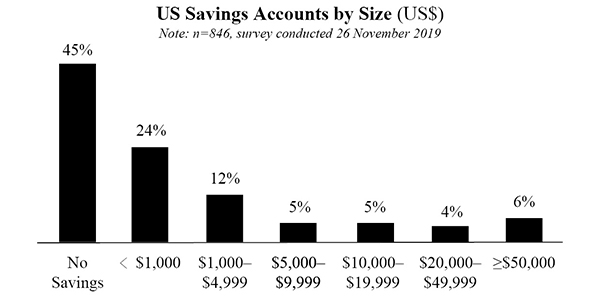
Source: statista.com
The economic structure is, without a doubt, broken. Wealth gaps are only widening, and economic instability is everywhere. It’s a reality that is hard to deny. The stock market and national average home values are back at all-time highs while tens of millions of Americans are filing for unemployment and half of society has practically no savings. It is suffocating many, and it applies globally. Politicians are simply not the answer. The fundamental problem with the current economic structure lies not in politics but in the currencies that coordinate economic activity (e.g., the dollar, euro, yen, peso, bolivar, etc.), and no politician can fix problems that stem from the structural flaws inherent to modern money.

Sources: US Employment and Training Administration, S&P Dow Jones Indices
A currency is the foundation of an economy because it coordinates all economic activity via trade. If an economy is functionally breaking down, it would be more appropriate to say that the underlying currency is not effectively coordinating economic activity. The currency is the input, and the economy is the output. In short, the fly in the ointment is the money. While many are focused on how to address massive wealth inequality, very few make the connection to the money everyone is using as the source of the problem. It’s not just that the economy is not working for many. The dollar as the primary mechanism for coordinating economic resources is failing everyone. Economic imbalance is the new normal, but nothing is normal about sustained imbalance. In fact, it is an economic oxymoron. Balance is critical to the functioning of any economy, and when functioning properly, an economy would naturally eliminate imbalance in its normal course. An economy that actively sustains imbalance, rather than eliminating it, is evidence itself of a broken economic structure. While the massive and growing economic imbalance that exists today is often believed to be endemic to capitalism, it is principally a result of central bank monetary policy and the failure of the dollar.

Portrait of Bitcoin Sign Guy during Janet Yellen’s Testimony (House Financial Services Committee Hearing on 12 July 2017) by Jim Fergus
Central bank monetary policy is the exogenous force creating economic distortion and extreme levels of inequality. The mere existence of economic inequality is not in itself an inequity. In fact, unequal outcomes are both natural and entirely consistent with economic balance. However, the inequality created and exacerbated by a flawed monetary system is an inequity. It is unnatural and exogenous to a free-market economy. The structural flaw inherent to the dollar currency system (or any fiat currency system) is the force most responsible for the sustained economic imbalance. Unsustainable and extreme wealth disparity follows from that imbalance. Every other distortive economic action or policy is secondary to the manipulation of the money itself. That is the root of all structural economic problems, and until it is fixed, the world will remain suspended in an increasingly fragile state. The legacy monetary system centralizes and consolidates wealth, which is the output of sustaining and exacerbating economic imbalance. It is a system that works for a few in the short term yet fails everyone in the long term. As imbalances grow, the currency’s ability to coordinate economic activity degrades gradually and eventually fails completely. When a currency fails, everyone pays the price—even those who initially benefited the most.
Bitcoin is the polar opposite. It is one currency that works for all, now and in the future. It eliminates imbalance as a natural function, wherever and whenever it appears, because its supply cannot be manipulated. With a fixed supply capped at 21 million and ever-increasing adoption, bitcoin is owned by more and more people as time passes, with each controlling a smaller and smaller share of the same fixed pie. The ownership of the currency naturally becomes more distributed and less concentrated over time, which provides the foundation for greater balance. Bitcoin levels the playing field and ensures that the monetary system cannot itself be a source of extreme inequity. It does so by guaranteeing certain inalienable rights. Every currency holder is assured that more units of the currency will not be arbitrarily produced, and each currency unit is treated equally within the network. Bitcoin coordinates economic activity more effectively because its pricing mechanism cannot be distorted or manipulated by exogenous forces, which is the fatal flaw of the legacy currency system. A fixed supply, equal protection, and true price signals deliver greater balance. Bitcoin fixes the economic foundation for everyone such that everything else can then begin to repair itself.
The Role of Money and the Price System
Think about money as the coordination function within an economy, where the utility of money is to intermediate a series of exchanges. Receive, hold, spend. It’s that simple.[93] Money is the intermediary good used to both quantify and trade value. As the market converges on a common form of money, a price system emerges, allowing the subjective concept of value to be more objectively measured. Money is the pricing mechanism, and the output is a pricing system. The price system communicates information. It aggregates individual preferences within an economy and communicates those preferences through local prices, as measured in a common monetary medium. Every time a good or service is priced and bought, that is a communication of preference. Change in prices reflects changes in preferences. And because preferences are ever-changing, so too are prices.
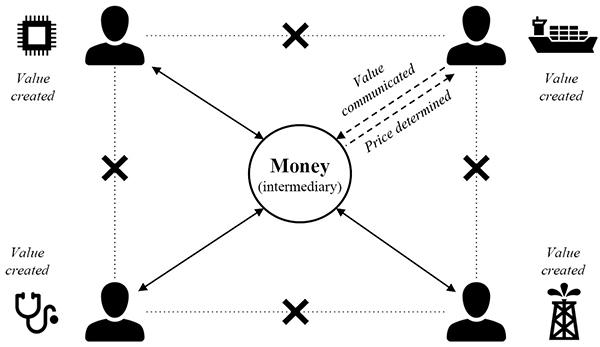
There are millions of goods within a developed economy, each with individual prices resulting in billions of relative price signals. Relative price signals ultimately communicate exchange ratios between various combinations of goods. While the value of any single good may be static for a period of time, certain prices are always changing within an economy, which dictates that relative prices are ever-changing. An economy constantly works to find balance through the aggregate changes in price levels. Every change, up or down, is an attempt to find balance and eliminate imbalance through trial and error. Everyone within an economy reacts to the price signals most relevant to their own preferences, which naturally change and become dynamically influenced by changing prices themselves. Through the price system, individual market participants learn what others value and what they need to produce to meet their own needs. As prices change, behaviors change, and everyone adapts. The price system is the visible hand that allows for balance to be achieved and for imbalance to be identified and eliminated. Long-term economic stability is achieved because variable information is constantly communicated through the price system. It is the fluctuation in prices, when not distorted, that actively prevents large-scale and systemic imbalances from forming.
Flaws of the Central Bank Mandate
Most central banks, including the Fed, have the authority to create money arbitrarily at no cost and have a mandate to maintain stable prices (i.e., a price stability mandate). This combination is fatal to the functioning of any price mechanism and ultimately to the underlying economy. When a central bank targets the stability of any price level, it works against the natural course of an economy, which seeks to find balance and adapt to changes in preferences through the price system. In the pursuit of price stability, central banks manipulate the money supply, distorting every price in the world. With each exogenous attempt to achieve price stability, existing imbalance is sustained and bad information is distributed to every person within the economy through false price signals, ensuring more imbalance accumulates. Imagine this happening each time the economy tries to find balance. By sustaining imbalance, those who benefit from its existence are advantaged at the expense of everyone else.
This process also impedes the ability of those on the lower end of the economic spectrum to contribute and to command a greater share of the resources within an economy. While increases and decreases to the money supply both distort economic activity, central banks increase the money supply over time, which has the effect of artificially maintaining higher price levels than would otherwise be sustained. Artificially inflated prices create an uphill battle for those who have little savings and do not own assets. Inflated asset prices become further out of reach for those who do not own them, and higher prices of goods financially squeeze those with the least savings the most. False price signals also induce poor economic decisions, disproportionately harming those on the lower end of the economic spectrum who can least afford errors and setbacks. While the manipulation of the money supply is counterproductive to everyone in the long run, there are winners and losers in the short term. The rich get richer and the poor get poorer.
As a tangible example, during the 2008 financial crisis, the value of real estate was declining. The economy’s price mechanism was communicating that an imbalance existed in the value of real estate. In aggregate, market participants were communicating an increasing demand for money relative to a decreasing demand to hold real estate. At that particular moment in time, the actual amount of money and the available supply of real estate were not rapidly or meaningfully changing. Instead, preferences within the economy were shifting, as were relative price signals. Rather than allow the economy to find balance and eliminate imbalance, the Fed increased the supply of dollars to “stabilize” the dollar value of real estate. More literally, it created $1.7 trillion to purchase mortgage-backed securities as a direct means to prop up the value of real estate, particularly the housing market. Those that owned real estate or operated businesses dealing in the production (or financing) of real estate benefited disproportionately, and at the direct expense of those that did not. Imagine someone saving to buy a home. Just as prices were coming down, which would have made a home more affordable, the Fed stepped in to increase the price of real estate, specifically housing, making it that much more expensive and further out of reach. The marginal benefit skewed to those who “had” at the expense of those who “had not,” just as it always does when imbalance is sustained.
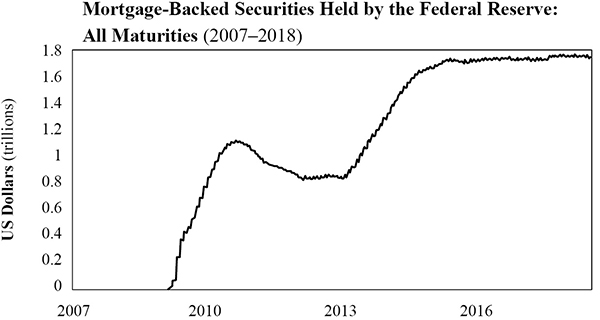
Source: Federal Reserve Economic Data (FRED)
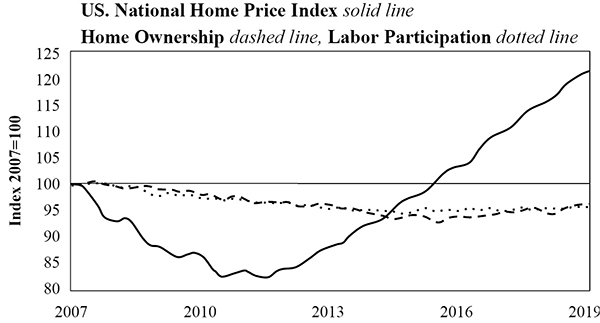
Sources: FHFA National Home Price Index, US Bureau of Labor Statistics
The Fed actively manipulated the value of real estate, but it also distorted all price signals within the economy by significantly increasing the money supply. The natural market function would have seen prices adjust to eliminate imbalance. But the Fed’s solution was the opposite. It devalued the money (by increasing its supply) such that the value of real estate (among other goods) as priced in dollars would change the least. Rather than eliminate imbalance, the Fed’s actions allowed imbalances to be sustained and actually grow. Sustaining imbalance is precisely what occurs each time the Fed intervenes to stabilize price levels. However, stability when achieved through manipulation merely suppresses volatility. It creates an unnatural rigidity in price when price fluctuation is both a desired state and the natural function of a market communicating changes in preferences to find balance. When imbalances that would otherwise be eliminated are allowed to be sustained through artificial means and for extended periods of time, it ultimately creates greater volatility in the long run and critically impairs the ability of a monetary medium to coordinate economic activity, which is its singular utility. Each time and cumulatively, it advantages and further embeds the incumbents, just as the market is working to eliminate imbalance.
Rather than have a billion people who actually make up an economy set prices, a few people unilaterally change the whole game by clicking some buttons on a computer screen; it distorts the entire value chain of the pricing mechanism.
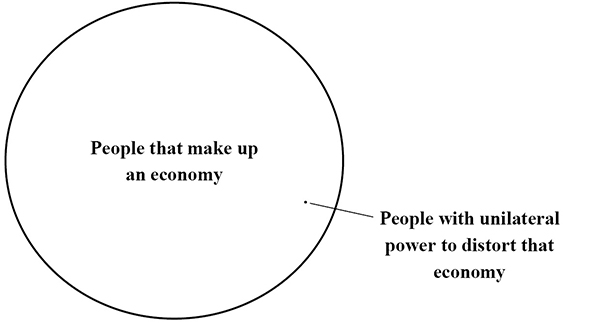
By manipulating price levels, the Fed isn’t just preventing smaller intermittent fires from naturally running their course. The accumulation of imbalances causes larger fires down the road. Think of the Fed as the arsonist that lights a fire, leaves through the back door in the middle of the night, and is then celebrated as the hero when it arrives through the front door to fight the fire with gasoline. A change in price levels, even if particularly volatile, is not a fire that needs putting out. Artificially preventing changes in price (i.e., a price stability mandate) is what lights the fire in the first place. The Fed co-opts the entire value chain of the pricing mechanism. Change in price is actually desired and the central bank works in opposition to that change by manipulating the money supply. The formation of imbalance within an economy is natural. Creating a centralized mechanism that prevents imbalances from being eliminated is the unnatural and damaging part. It also creates long-term economic instability by distorting price signals over decades and widens the wealth gap by constantly advantaging those on the right side of the imbalances. Predictably and unironically, the existence of the central bank’s price stability mandate, combined with the power to print money, causes both long-term instability and sustained economic imbalances—exactly as Hayek forewarned.
In fact, in the case discussed, the very measures which the dominant “macro-economic” theory has recommended as a remedy for unemployment, namely the increase of aggregate demand, have become a cause of a very extensive misallocation of resources which is likely to make later large-scale unemployment inevitable. The continuous injection of additional amounts of money at points of the economic system where it creates a temporary demand which must cease when the increase of the quantity of money stops or slows down, together with the expectation of a continuing rise of prices, draws labour and other resources into employments which can last only so long as the increase of the quantity of money continues at the same rate—or perhaps even only so long as it continues to accelerate at a given rate. What this policy has produced is not so much a level of employment that could not have been brought about in other ways, as a distribution of employment which cannot be indefinitely maintained and which after some time can be maintained only by a rate of inflation which would rapidly lead to a disorganisation of all economic activity. The fact is that by a mistaken theoretical view we have been led into a precarious position in which we cannot prevent substantial unemployment from re-appearing; not because, as this view is sometimes misrepresented, this unemployment is deliberately brought about as a means to combat inflation, but because it is now bound to occur as a deeply regrettable but inescapable consequence of the mistaken policies of the past as soon as inflation ceases to accelerate.
Most mainstream economics professors readily agree that price-fixing or setting quotas on certain economic goods naturally creates economic inefficiency and imbalance. However, the same experts then turn around and avidly defend central bank monetary policy, ignoring the fundamental inconsistency. Economic manipulation is economic manipulation. Rigidity in the price or quantity of any economic good driven by exogenous forces results in imbalance. Variance allows for balance and equilibrium. It is a logical and uncontroversial view. Why then is the same principle not understood when applied to money? Imbalances are created when central banks target interest rates by manipulating the money supply, just as imbalances are created when the Venezuelan government arbitrarily sets the price of a gallon of gas below its market value. Ironically, manipulating the money supply happens to be economically more destructive because it distorts all prices within an economy, including relative price signals (as individual price levels do not adjust proportionately). When the Fed pursues its price stability mandate, it actively sends false price signals throughout an economy, causing imbalances in supply and demand structures to be sustained. Price stability is price manipulation. Predictably, manipulating the price of money to achieve any definition of stability causes a degree of economic distortion far worse than the manipulation of any single market.
We must look at the price system as such a mechanism for communicating information if we want to understand its real function—a function which, of course, it fulfills less perfectly as prices grow more rigid. (Even when quoted prices have become quite rigid, however, the forces which would operate through changes in price still operate to a considerable extent through changes in the other terms of the contract.) The most significant fact about this system is the economy of knowledge with which it operates, or how little the individual participants need to know in order to be able to take the right action. In abbreviated form, by a kind of symbol, only the most essential information is passed on, and passed on only to those concerned. It is more than a metaphor to describe the price system as a kind of machinery for registering change, or a system of telecommunications which enables individual producers to watch merely the movement of a few pointers, as an engineer might watch the hands of a few dials, in order to adjust their activities to changes of which they may never know more than is reflected in the price movement.
Consequences of Sustaining Imbalance
The effects of sustaining imbalance can be best understood and observed through the credit system, which is where the Fed directly intervenes and consequently where the greatest distortion and imbalance exists. As the economy slows, the Fed increases the supply of dollars in the financial system by purchasing debt instruments (typically government treasuries) and crediting the sellers’ accounts with newly created dollars. At the onset, the credit system was just a tool to effect monetary policy. It was the mechanism through which the Fed pursued its price stability mandate. The playbook was as follows. The Fed would increase the supply of dollars by purchasing credit instruments and reduce interest rates by the same mechanism. This would induce economic expansion via cheap credit, and general price levels would stabilize. At least, that was the theory and intent.
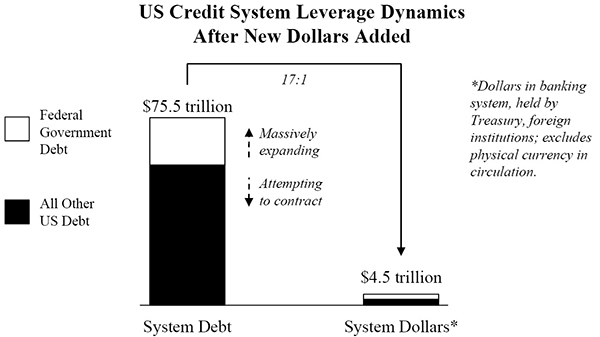
Source: Board of Governors, Federal Reserve System (US); data as of the time of original publication (August 2020).
Now the tail is wagging the dog. Today, the credit system in the US stands at more than $75 trillion systemwide, whereas there are only $4.5 trillion actual dollars within the banking system. Approximately $17 of dollar-denominated debt exists for every dollar (a debt-to-dollars ratio of 17:1). This degree of leverage is an economic imbalance, and it is only sustained as a function of the Fed. Each time the credit system attempts to contract, the Fed creates more dollars to help maintain the size of the credit system such that it can further expand. Because the credit system is now orders of magnitude larger than the base money supply, economic activity today is largely coordinated by the allocation and expansion of credit rather than by the base money itself. In aggregate, the credit system is the marginal price setter, given its size relative to the base money supply. The Fed’s price stability mandate necessitates maintaining the size of the credit system, and in order to do so, the Fed must target asset prices that support existing debt levels. It has become circular. The Fed used the credit system as a tool to stabilize price levels, but now, to maintain stable prices, it must maintain the size of the credit system.
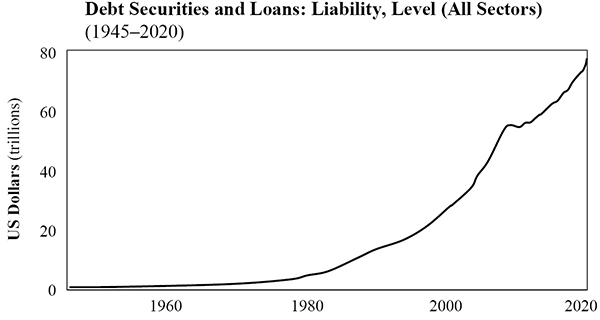
Source: Federal Reserve Economic Data (FRED)
This vicious cycle only exists because the Fed has unilateral control of the money supply, which was not always the case. In 1971, President Nixon officially ended all convertibility of dollars to gold,[96] and the US government later decoupled the dollar’s value from gold altogether in 1976. The Fed’s creation in 1913 and President Roosevelt’s 1933 ban on the private ownership of gold might have set the stage,[97] but the complete departure from gold as a monetary anchor in the 1970s removed constraints that otherwise prevented the true centralization of the money supply. Ever since, the Fed has had unilateral control of the money supply, and the removal of these constraints paved the way for the Great Monetary Inflation, a phenomenon Paul Tudor Jones recently wrote about.[98] The sea change in the 1970s is what opened the door for the Fed to take a more central role in actively managing the economy via the money supply. As a direct consequence, the base money supply and the credit system have expanded over the past five decades in ways that would otherwise not have been possible. Imbalances have been allowed to grow consistently over time, creating long-term economic distortions.
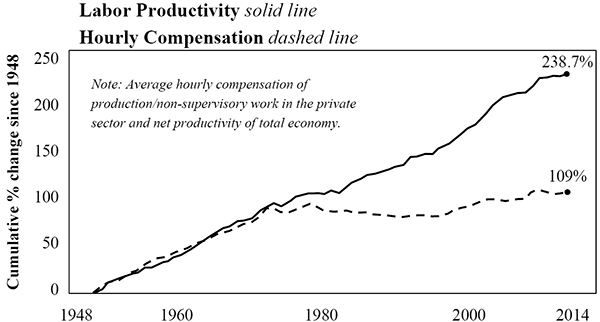
Source: Source: Economic Policy Institute (data: US BEA, BLS)
When imbalances emerge in the credit system (i.e., too much debt relative to dollars), the Fed supplies more dollars such that existing debt levels can be sustained. Rather than write off bad debt and reduce existing debt levels, imbalances are actively sustained rather than eliminated. This is why the banking sector has become so large and the function of credit so central. It would not have been possible if the Fed could not print money to sustain otherwise unsustainable levels of debt, all in pursuit of “price stability.” Effectively, each time the banking sector would otherwise contract, the Fed undertakes measures to prevent it. It sounds crazy because it is. But the credit system exists the way it does because it is the primary transmission mechanism of the Fed’s monetary policy. The Fed needs the credit system to be maintained because it is through this vehicle that the Fed attempts to “manage” the economy. The Fed sees targeting asset prices to sustain debt levels as less disruptive than allowing debt to be restructured and written off. From the perspective of the Fed, it’s six one way, half a dozen the other. Effectively the same, but with less disruption. In reality, one path is economic manipulation of the worst kind, and the other is the natural and organic rebalancing of an economy in imbalance.
While it should be obvious that asset price targeting advantages those with assets (the wealthy) and is a regressive tax on those without assets (the poor), the Fed does have a price stability mandate. For those on the lower end of the economic spectrum with little to no savings, cash naturally represents most, if not all, of one’s savings. Those at the higher end of the economic spectrum typically hold cash in addition to equity in businesses, real estate, and financial assets such as stocks and bonds. Again, consider the 2008 financial crisis. There were imbalances in the housing and financial markets. Prices were at unsustainable levels. As imbalance was in the process of being organically eliminated and price levels were correcting, the Fed stepped in to “stabilize” asset prices. Imagine if you had just entered this economy without any savings, a home, or stocks and bonds. Everyone who owned assets received a bailout at the expense of those who did not, all in the name of price stability.
Increasing the supply of dollars naturally causes the value of each dollar to decline. Wages (labor) paid in dollars were devalued, and asset prices were directly manipulated higher. Inflation of almost all consumer goods broadly followed. It is the equivalent of being hit from both sides for those lowest on the economic spectrum without assets and little savings. Wages purchase less with each passing day, and it becomes measurably more difficult to accumulate the amount of savings necessary to purchase assets. Initially, the effects are, at best, zero-sum. Those at the top benefit and those at the bottom suffer. In the end, everyone loses because the end game is economic instability. Notice the negative correlation below between housing prices and housing affordability (Figure 16.12), and then recognize that the Fed actively manipulates housing prices. Also recognize that housing prices are at an all-time high (above 2007 bubble levels) while nearly half the country has no savings. This scenario can only exist in a manipulated world, and it crushes those without savings.
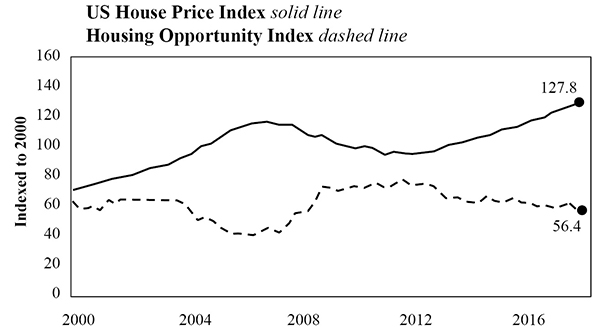
Source: Statista.com (data: US FHFA, National Association of Homebuilders)
The economists running the show and those who benefit the most will overwhelmingly agree it has to be done (every time). History is written by the winners, after all. But it is still all smoke and mirrors regardless of any proffered justification.
Sure, it was a crazy experiment, but the Fed had no other choice. Just imagine all those on the lower end of the spectrum that would have lost their jobs if not for the Fed’s actions. Without a job, the poorest on the economic spectrum would have been far worse off and would not have been able to afford a home.
This is the common, predictable defense. The same line has certainly been used to defend the Fed’s most recent actions in response to the global pandemic (printing $3 trillion, with a T). While it may seem like logic, it lacks any fundamental economic argument in defense of the manipulation of price levels. The narrative is caught in a vicious cycle that begins with economic imbalance as a starting point (and one created by decades of the same distortive monetary policy). Recall the role of the arsonist hailed as a hero fighting the fire. You cannot dig yourself out of a hole by continuing to dig in the same direction. At a fundamental level, manipulating price levels allows imbalances to be sustained that would otherwise course correct. It disproportionately advantages those that contributed to, and benefited the most from, the very existence of imbalance—like having your cake and eating it too, or like getting a second bite at the apple. Those who took an inadvisable risk get bailed out, rather than penalized, and the world of imbalance is sustained. The advantages gained from manipulated incentive structures are allowed to continue in a way that would not be possible absent the Fed’s policy decisions.
An Unmanipulated Economic Structure
While there is never perfect balance, the existence and fluctuation of price levels are how an economy works toward balance through trial and error. Every individual reacts differently to an ever-changing set of price signals. It is how people evaluate which businesses to create, which skill sets to acquire, and which jobs to pursue. All of which are interdependent on each individual’s interests, values, and capabilities. Imbalances can naturally arise within an economy as individuals speculate and overinvest in certain segments based on imperfect expectations of consumer preferences. That is the nature of trial and error. Nobody knows or can predict the future. Price signals are used to best guide decisions. A business or individual produces a good for x and attempts to sell it for y. If insufficient demand exists to make the activity profitable, that is the market communicating information to the producer. Better luck next time. Build something else or find another method that provides greater value (or is valued by more people). Imbalances are eliminated through this process. Those that take the risk own the consequences. It’s a never-ending game that marries individual ideas and skills with the preferences of other market participants.
Prices and profits are all that most producers need to be able to serve the needs of men they do not know. They are tools for searching—just as, for the soldier or hunter or seaman, the telescope extends the range of vision.
Money is the tool used to coordinate resources and to test the market by trial and error. It is the foundation of a price system that distributes information to all participants—the better the money, the more reliable the price system. And the more reliable a price system, the greater the balance in an economy. Those who deliver the greatest value to the largest number of people within an economy are naturally rewarded with the most money. But money would be of little value to the producer if others were not also producing goods that they themselves valued. The system would not sustain itself if balance did not exist. Purchasing a good or service from another individual requires that one must have first earned money. And providing goods valued by others is a far better outcome for everyone in aggregate than money being acquired through any other means (such as stealing or printing). It is the only way for the cycle of trade to be repeatable and symbiotic rather than one-off and zero-sum. What good is a customer that runs out of money or doesn’t have any in the first place? In a balanced economy, every producer is a customer of someone else and vice versa. As the old saying goes, “Give a man a fish, and you feed him for a day; teach him how to fish, and you feed him for a lifetime.”
One need not be religious to comprehend the wisdom. Everyone is incentivized to produce output valued by others within an economy, and each individual benefits from more people producing a wider range of goods or services. All participants have a selfish interest in delivering value to others and helping others contribute value in return. But this is not just a naive or hopeful economic view of the world. There are discernible benefits to trade, specialization, and a broader range of choices for all individuals. Money coordinates the division of labor, and the form of money with the most reliable pricing mechanism will consistently deliver the greatest value with the widest range of choice and balance. The pricing mechanism with the least distortion provides the clearest signals as to what others value and, derivatively, provides the greatest assurance that the information communicated is not a false signal. When free of manipulation, the function of a monetary medium and its price system naturally eliminates imbalance. It is the governor of the economic system that creates balance and enables symbiotic relationships to continuously be discovered through trial and error.
A Manipulated and Broken Economic Structure
The Fed’s monetary policy actively prevents the economy from restructuring and finding balance. When imbalance exists, efforts to maintain price stability equate to maintaining otherwise false price signals. Productive assets remain in the hands of a few, and the world remains suspended in a state of imbalance. Money that does make its way to those on the lower end of the economic spectrum inevitably finds its way back to the owners of productive assets. The natural healing process is stymied each time the Fed intervenes as the economy cannot sustainably cycle money through trade in a symbiotic way. The skill sets and preferences of market participants remain out of sync. By pumping money into a structurally broken economy, the Fed is giving a man a fish while preventing him from learning how to fish. The existence of imbalance indicates that the composition of an economy is not meeting the needs of participants that make up the market. If the economy were allowed to restructure, the individuals and assets that capture an otherwise unsustainable share of wealth would not continue to do so.
When the Fed intervenes to keep the dream alive, it prevents the economy from rebalancing and creates inequity. Giving all benefit of the doubt, the Fed believes it is helping. It sees its activities as smoothing out market signals rather than manipulating them. The foundational assumption of the Fed’s economic theory is that active management of the money supply is a positive economic force. Active management of the money supply is in its DNA—it is a question of how much and when, not if. Would anyone expect the Fed to be an honest evaluator of its actions? It would be like grading your own test. No one would reasonably expect an objective assessment because there can be no objectivity. Certain false assumptions are encoded as true, which prevents the possibility of objectivity. The societal consequences have been disastrous, yet the Fed looks everywhere for answers, except in the mirror. And so it persists. The same policies are repeated over and over, always with the expectation of a different result.
Inequality is something that has been with us increasingly for more than four decades; it’s not really related to monetary policy. It’s more related to [stutter] there are a lot of theories on what causes it, but it’s been something that’s more or less been going up consistently for more than four decades, and there are a lot of different theories, one of which is just that globalization and technology call for rising levels of skills and aptitudes and education and that US educational attainment flattened out, certainly relative to our peers, over that period.
Fed Chairman Powell recently provided this statement in response to a question about the Fed’s contribution to increasing wealth inequality. Notice how the answer is not an argument for why central bank policy does not cause imbalance and inequality but more of a pronouncement followed by “look over there.” Never believe the myths about globalization and technology driving wealth inequality. Nothing about technology, innovation, and globalization causes sustained economic imbalance or a structurally expanding wealth gap within an economy. For innovation to be valuable, it must, by definition, solve a problem for a range of people who can afford it. Value becomes self-referencing in that sense. Economic balance is a governing input to value. To believe the tall tales that technology and globalization cause economic imbalance, one would have to be willfully blind to the impact of centralizing the money supply. This centralization, in turn, caused banking to become the epicenter of the economy, making it possible for imbalance to be sustained as a policy decision over decades. There may be many theories, but the manipulation of every price signal within the economy is ground zero to economic imbalance and inequity. The structural flaw in the foundation creates the unlevel playing field off of which all other contributing factors compound.
If A then B—if not A then not B
Money is the bedrock of economic systems. Understanding the fundamental and foundational role money plays in the economic engine establishes the logical connection between systemic economic issues of imbalance and the artificial manipulation of the money supply. Of course, there are other factors at play. The money supply is not the only way economic activity is manipulated. Tax policy, government spending, and the regulatory apparatus all contribute. However, focusing on these factors would be like trying to fix the windows on the hundredth floor of a building while a single Jenga block is supporting the foundation. That is the relationship between the issues inherent in the monetary system (the foundation) and all other economic issues (higher levels). The core problem that bitcoin solves is the foundation. If everyone displayed a little humility, each would recognize that there is no silver bullet to solve the structural problem of a widening wealth gap and economic imbalance. There is no individual with a plan or a piece of legislation that will make everything better. The imbalance created by central command does not get solved by central command—quite the opposite. The only real hope is to fix the foundation so everyone can get back to doing the desirable things without the need for conscious control. From there, balance will follow.
But those who clamor for “conscious direction”—and who cannot believe that anything which has evolved without design (and even without our understanding it) should solve problems which we should not be able to solve consciously—should remember this: The problem is precisely how to extend the span of our utilization of resources beyond the span of the control of any one mind; and therefore, how to dispense with the need of conscious control, and how to provide inducements which will make the individuals do the desirable things without anyone having to tell them what to do.
With a fixed supply of 21 million, enforced on a decentralized basis and controlled by no one, bitcoin has removed the ability to manipulate the monetary function entirely. What do you do when misbehaving children cannot find a way to share a toy? You take the toy away. The relationship between bitcoin and central banks is similar. Because no human (or institution) can be trusted with control over the money supply, the only practical solution is to remove the ability and temptation altogether. The one constant in bitcoin is its fixed supply. There will only ever be 21 million bitcoin, and there is nothing anyone can do about it. Everything will change around bitcoin, but its supply will increasingly provide the constant from which to measure all other activity. It’s a source of truth that ensures a level playing field. Because the supply of bitcoin cannot be manipulated, neither can its price signal. Undistorted price signals communicate more reliable information. But never confuse more reliable information and a level playing field with price stability or the issue of volatility. If the value of bitcoin is $12,000 today and $10,000 tomorrow, that is the undistorted communication of information.
Variation is information. When there is no variation, there is no information. […] There is no freedom without noise—and no stability without volatility.
A fixed supply ensures that any price change is driven exclusively by a change in demand rather than an artificial and unpredictable change in the supply of money (i.e., communicating a change in preferences to the entire economy). It permanently eliminates an entire side of the equation, which today heavily influences price changes and distorts the communication of preferences. Imagine knowing with absolute certainty that every price change was a product of a shift in consumer preferences rather than the effects of increases or decreases in the money supply. It’s the difference between having true economic price signals to rely on and constantly navigating the unpredictable downstream effects of erratic monetary policy. Today and into the future, the same principle will hold. Everyone will be able to rely on bitcoin’s fixed supply and trust that changes throughout bitcoin’s price system will always be true, free from unpredictable changes in the money supply.
This fundamental difference between the existing monetary structure and bitcoin changes the entire game—false price signals vs. true price signals. False price signals are equivalent to studying for a test believing you have a cheat sheet with the answers, training yourself based on that information, and then showing up only to find out that the test was entirely different. Everyone believes their actions are responses to reliable information (price signals), not realizing the information is being constantly manipulated by changes in the money supply. Each time a violent shock occurs within the system, everyone gets a hint that price signals are communicating bad information. The Fed steps in to stabilize prices, reassuring everyone to carry on while relying on the same bad information. This process has occurred every time the economy has attempted to rebalance structurally over the past fifty years. It is the primary reason violent shocks to the system are even possible. False signals try to correct, only to be sustained and exacerbated by exogenous forces.

With a fixed money supply, this wrong is righted permanently. It will no longer be possible to sustain imbalance. So long as bitcoin exists, the monetary medium will not be capable of distributing distorted price signals. There is a difference between right, wrong, and true. True price signals ensure that the information being communicated reflects the individual and aggregate preferences of an economy. In that sense, there is no right or wrong so long as the information can reasonably be relied upon as accurate and undistorted. No one has to trust or question whether bitcoin’s price signals are true because its fixed supply guarantees it.
Figuring out how to play a rigged game is no longer necessary because the rigged game is ending. The days of monetary inequity will soon be over as bitcoin distributes throughout the world. It will shift the balance of power back to those that actually create value, as defined by true price signals, which are communicated by individuals that hold the currency. Setting aside taxes and regulatory capture for a moment, if one wants to acquire bitcoin, he or she will have to provide value in return, and bitcoin will become the arbiter of that value. Of 21 million, approximately 18.5 million bitcoin are already in circulation as of the time of writing. The 18.5 million in circulation are all held by some individual or entity. In order to acquire any, bitcoin must be earned by delivering value to those that hold the currency. Even for those not yet circulating, every single bitcoin must be earned by contributing value. The same is not true of the current monetary system. In the current structure, dollars can either be earned by delivering value to others within the economy, or conversely, if the Fed decides to hand out more money. And this happens quite frequently. Of all the dollars that exist today, over 80% have been created and allocated by the Fed since 2008 (see Figure 16.16), rather than by the alternative—delivering value to others within the economy. Which system sounds more fair, balanced, and conducive to aligning incentives throughout an economy over decades and generations?
As more people adopt bitcoin, the currency is transferred from the haves to have-nots. By making the nominal amount of bitcoin zero-sum, it ensures that the economic system as a whole is non-zero-sum. To join the economy, you must deliver value to someone within the network. No value leaks outside the system. No inefficiency can be introduced through the production of money. Whether new entrants are joining the network or trade occurs between existing participants, bitcoin is always being transferred, and through that transfer, value is actually created. Recall that the valuable function of money is to coordinate economic activity. The production of money, on the other hand, creates no value and only serves to distort and impair the ability of a monetary medium to properly function. The nominal amount of money is not important. What is important is its ability to communicate reliable information and trade value between a broad set of economic participants.
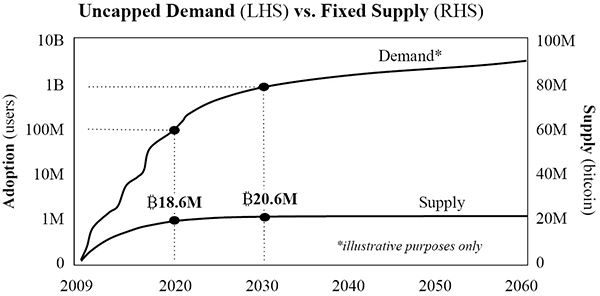
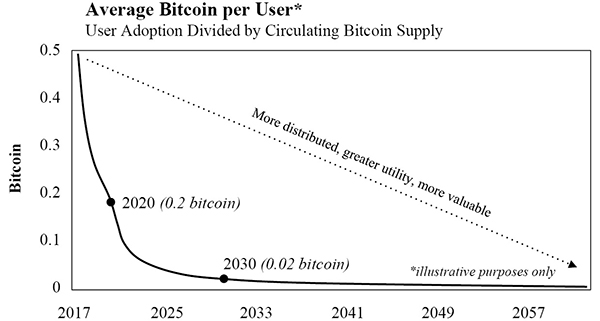
Money allows individuals to understand the relative value of their output and the relative preferences of others. Bitcoin, with a zero terminal rate of change, enables individuals to make better decisions (on average) in the pursuit of their own interests with more reliable information, free from distortions created by changes in the money supply. A fixed amount of currency combined with a growing number of people valuing it results in increased distribution of the currency over time. No more than 21 million bitcoin will ever exist, and no more than 21 million can ever be saved. Paradoxically, this will drive more people to save as the threat of debasement is eliminated. And as more people save in a currency with a fixed supply, it results in more and more people owning less and less. But through this function of more people possessing savings, economic stability is created. A fixed money supply naturally causes the currency to become further decentralized and more distributed, delivering greater balance.
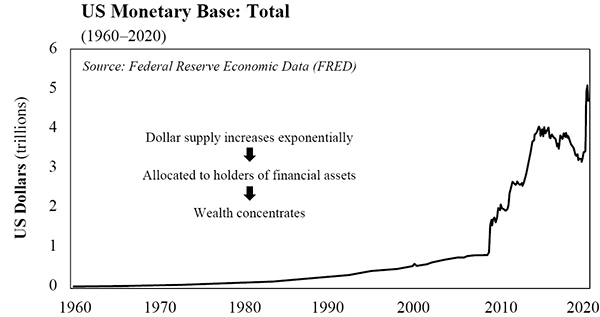
Centralized governance of the money supply allows the distribution of new currency units to consolidate, whereas a decentralized governance model enforcing a fixed supply ensures greater distribution of the currency over time. Follow the money. A centralized money supply causes wealth to centralize, and a decentralized money supply causes wealth to distribute. The structure of the currency dictates the respective wealth effects, and this trend can be observed in actual data. Bitcoin held in smaller denominations continues to grow steadily, while bitcoin held in larger denominations continues to decline. As the economic system grows, the currency becomes more widely distributed. The nominal amount held by each individual decreases (on average) while purchasing power increases. As more people demand the currency, its value rises. However, there is a terminally fixed supply. As increased demand naturally outpaces ever-diminishing increases in supply, there becomes one principal way to acquire bitcoin: by delivering value to an existing currency holder. Over time, the currency transfers from relatively few early holders to a more widely distributed base. Everyone wins. The network utility increases as more participants voluntarily opt in, and the distribution of the currency becomes less and less concentrated, ensuring greater balance and reducing systemic risks posed by the existence of a few extremely large holders.
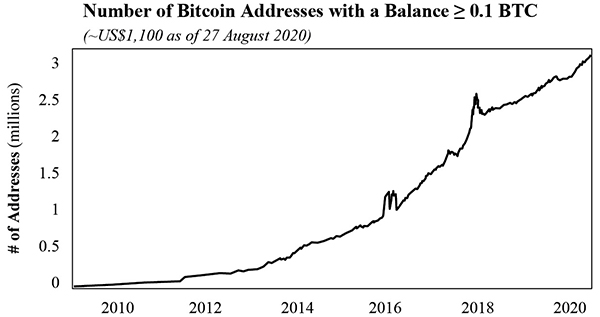
Source: glassnode.com
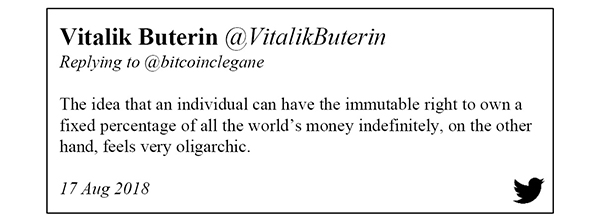
Source: glassnode.com
When a monetary medium’s incentives align individual and aggregate interests, non-zero-sum outcomes become the default, as does balance. Bitcoin is accessible to anyone, and everyone is afforded the same protections. Anyone that produces value and exchanges it for bitcoin is assured that their output will not be devalued in the future merely as a function of someone creating new units of money. Separately, everyone benefits from undistorted price signals. In bitcoin, both rich and poor alike receive these same protections equally. While it is no guarantee that someone else will value the currency more or less, it eliminates the possibility of a forced devaluation of labor and output stored in a monetary medium. In the current economic structure, the wealthiest better understand the effects of active monetary debasement and are best equipped to combat it. Logically, those on the lower end of the economic spectrum have more to gain by leveling the playing field. But fundamentally, it is not about rich and poor. Everyone benefits from the elimination of money production and an economy that provides greater balance, with more reliable information.

In a 2018 tweet, the founder of Ethereum (Vitalik Buterin) beautifully and ironically described the value of holding a currency with a fixed supply that could not be manipulated while arguing for the opposite. He made the precise argument that central bankers use to defend their actions while also articulating the power it would give the individual. While Buterin believes it to be oligarchic to have the immutable right to own a fixed percentage of all the world’s money indefinitely, what if that right were extended to the poorest people on earth? What if it were applied equally to every single person on earth? That is the power of bitcoin. Suppose you live in one of the poorest countries in the Western Hemisphere, such as Nicaragua, and choose to exchange your value for bitcoin. In that case, you now have an immutable right to own a fixed percentage of all the world’s money indefinitely. Only you can decide when, how, and to whom to transact for value received in the future. The poorest in Nicaragua are suddenly elevated to the same leveled playing field as a billionaire in New York, such as Paul Tudor Jones. Within the bitcoin network, there is no distinction. Equal rights are the default. This feature cannot and does not exist in the legacy financial system. It is far more oligarchic to indiscriminately devalue someone’s monetary savings by increasing the money supply and then choosing who should be rewarded with this new money. There is no comparison between such a world and one where individuals can earn money honestly by producing value for others and are free to determine how best to allocate it for value in the future.
The idea that bitcoin could solve problems today for rich and poor alike stumps quite a few. Most consider bitcoin a speculative asset unfit for people without a certain level of discretionary savings, due to its volatility. It is easy to look at an economic disaster like Venezuela, where the vast majority of people are struggling to have their basic needs fulfilled (i.e., reliable access to food, water, power, and healthcare) and believe there are more urgent concerns than “buying” bitcoin. However, it is hard to ignore the fact that a deterioration in the money caused the economic collapse. Reliable access to food, water, power, and healthcare doesn’t exist without the use of money to coordinate resources. The only viable long-term solution is to use a form of money that better fulfills that coordination function. Rebuilding an economy on top of a new form of money requires that someone goes first. Just because it is hard to imagine doesn’t change the reality that it’s the only way out. One action triggers another and another and another. Whether it’s Venezuela, another country suffering from rapid economic deterioration, or any poverty-stricken area in the developed world, the need for assistance is immediate. But there is no quick fix. Bitcoin can’t remove a socialist dictator, it can’t take the kleptocrats out of the kleptocracy, it can’t reverse damaging tax policy or social programs, and it can’t magically turn poor people into rich people or vice versa. However, it can solve problems today for anyone determined enough to use it, regardless of economic status.
The inception point of elevating any individual or society is finding a way to produce more value than is consumed. The best way to accomplish that goal is by using money to exchange value, save value, and coordinate economic activity. Bitcoin isn’t just a tool for the rich that will become serviceable to the poor once enough of the rich people have acquired some. That would be nonsensical. There is no reason why a superior form of money would perform one function for some and not others (regardless of wealth, income level, or any other reason). Instead, bitcoin—as that superior form of money—is the best way anyone can level the playing field, irrespective of whether the path may be more challenging for some than others. The demand for money is near-universal, and over time, anyone using the form of money with the strongest foundation and the truest price signals will benefit. The dollar (and all other fiat currencies) benefits a few in the short term at the expense of everyone in the long term. Bitcoin, on the other hand, fixes the economic foundation for everyone. It is one for all.
Whether in Rome, Constantinople, Florence, or Venice, history shows that a sound monetary standard is a necessary prerequisite for human flourishing, without which society stands on the precipice of barbarism and destruction.
-
Rep. Alexandria Ocasio-Cortez, speech, Democratic National Convention, 18 August 2020, Milwaukee, WI. ↩
-
Credit to Pierre Rochard for this distillation. ↩
-
Friedrich A. Hayek, “The Pretense of Knowledge,” Lecture in the Memory of Alfred Nobel, 11 December 1974, Stockholm, Sweden. ↩
-
Friedrich A. Hayek, “The Use of Knowledge in Society,” American Economic Review 35, no. 4 (September 1945): 526–527. ↩
-
Richard Nixon, public address to the nation, 15 August 1971. ↩
-
Franklin D. Roosevelt, Executive Order 6102—Forbidding the Hoarding of Gold Coin, Gold Bullion and Gold Certificates, 5 April 1933. ↩
-
Paul Tudor Jones and Lorenzo Giorgianni, “Market Outlook—Macro Perspective: The Great Monetary Inflation” (whitepaper, 9 May 2020). ↩
-
Friedrich A. Hayek, The Fatal Conceit: The Errors of Socialism (University of Chicago Press, 1988), 104. ↩
-
Jerome Powell, Press Conference, 10 June 2020. ↩
-
Friedrich A. Hayek, “The Use of Knowledge in Society,” American Economic Review 35, no. 4 (September 1945): 527. ↩
-
Nassim N. Taleb and Mark Blyth, “The Black Swan of Cairo: How Suppressing Volatility Makes the World Less Predictable and More Dangerous,” Foreign Affairs 90, no. 3 (May/June 2011). ↩
-
Saifedean Ammous, The Bitcoin Standard: The Decentralized Alternative to Central Banking (Wiley, 2018), 30. ↩